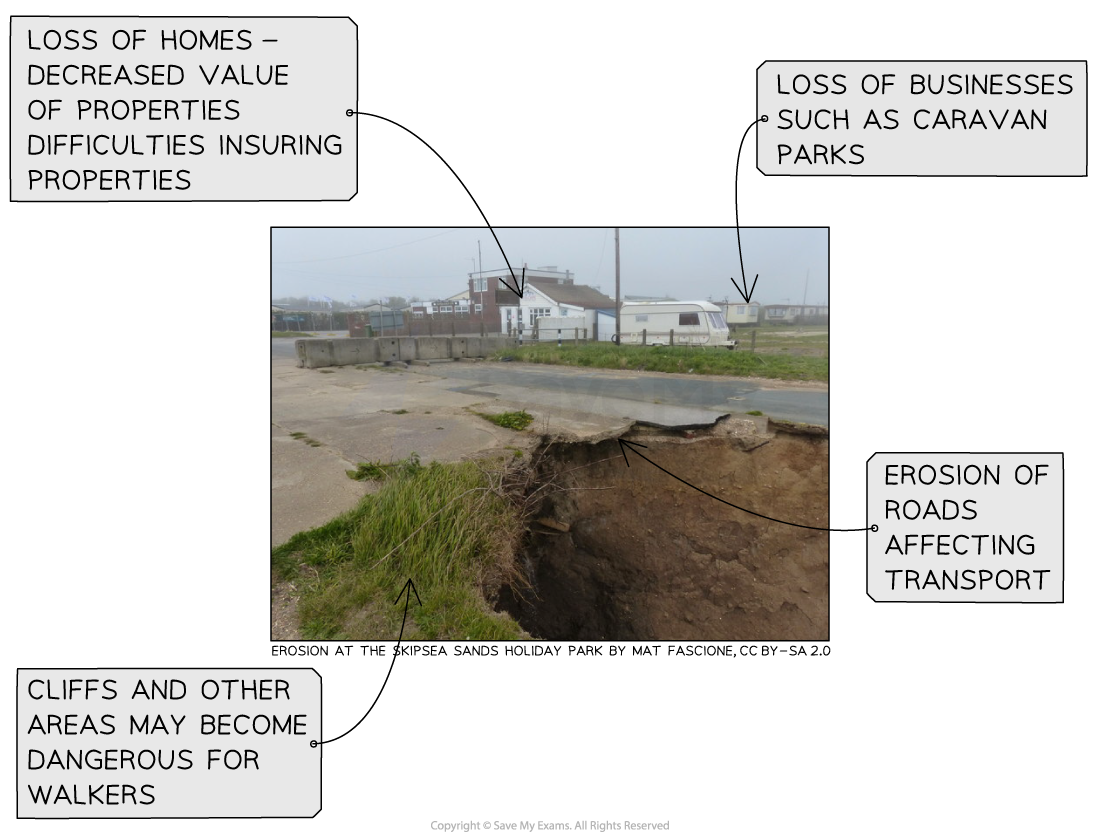Human Activities on Coastal Landscapes (Edexcel GCSE Geography A): Revision Note
Exam code: 1GA0
Impacts of Human Activity at the Coast
Coastal areas provide many opportunities for human activities
Human activities at the coast affect coastal landscapes and processes
It is estimated that approximately 8 million people live in coastal communities in the UK
The effects of human activities may be:
Direct or indirect
Positive or negative
Table of Impacts on Coasts
Activity | Impact |
|---|---|
Urbanisation | Buildings on the coasts increase the weight pressure on cliffs A coastal location increases the demand for housing Buildings and tarmac affect the drainage patterns This can lead to soil saturation Roads and other transport routes may be affected |
Agriculture | Increased soil erosion Leads to increased sedimentation Clearance of trees and vegetation can lead to more surface run off and reduced coastal habitats Farmland may be lost due to rising sea levels and coastal erosion |
Industry | Nuclear power stations such as Sellafield and Hinkley Point are located by the coast Concerns regarding radiation leaks, such as at Fukushima in Japan Gas terminals such as Easington in East Yorkshire can be vulnerable to coastal erosion Any industries by the sea increases water, air and noise pollution The industries bring jobs and income to the local area May destroy animal habitats |
Impacts of Coastal Recession & Flooding
Coastal Recession
Coastal retreat is also known as coastal recession
It occurs as a result of coastal erosion
Coastal areas erode at different rates
The fastest-eroding coastal areas are moving inland at an average rate of 2 metres a year
Coastal recession can happen gradually
It can also happen rapidly when there is a landslide and a large area of land is eroded at once
Impacts of coastal recession
The loss of land as a result of coastal recession can have a variety of impacts

Impacts of coastal recession in Skipsea, East Yorkshire
Loss of transport routes, including rail and road, can lead to long and expensive detours
Farmers may lose land, which reduces their income
On the Holderness coast in East Yorkshire, in the last 1500 years, 5km of land has been lost to coastal recession
This includes over 25 villages
It is expected that rising sea levels and more severe storms resulting from climate change will increase coastal recession
Coastal flooding
Coastal flooding occurs when the land is submerged by seawater
The two main causes of coastal flooding in the UK are:
Rising sea levels
Storms and storm surges
Rising sea levels
Since 1900, the average sea level around the UK has risen between 12 and 16cm
By 2050, it is estimated that they will have risen by a further 35cm
As a result, 200,000 coastal properties and businesses will be at risk
Storms and storm surges
It is predicted that climate change will result in an increased frequency and severity of storms
This will lead to increased risk of storm surges

A storm surge
Storm surges combined with high tides place more areas at risk
In 1953, a storm surge in the North Sea led to:
Over 300 deaths
Damage to 24,000 properties
The loss of 160,000 acres
Impacts of coastal recession and flooding
Flooding of coastal areas may result in:
The destruction of wildlife habitats
Damage to homes and businesses
Difficulties getting insurance or increased cost of insurance
Decreased value of properties
Damage to road and railway routes

Unlock more, it's free!
Did this page help you?